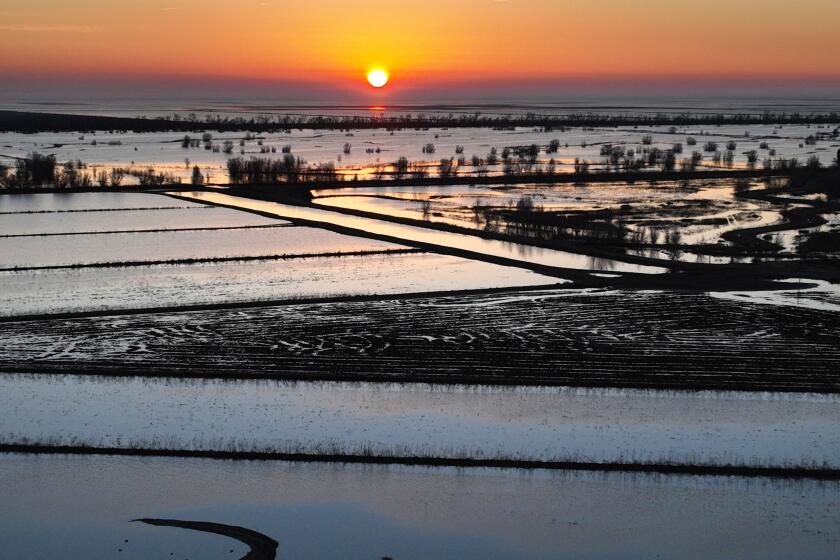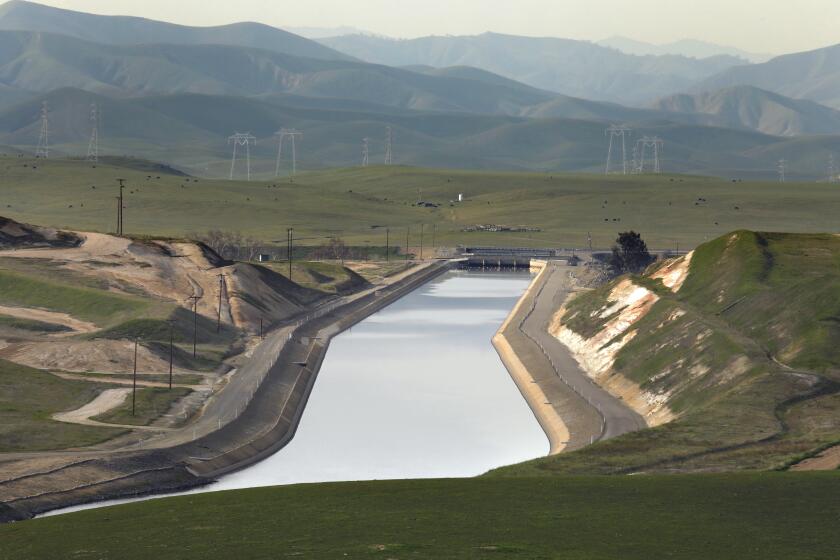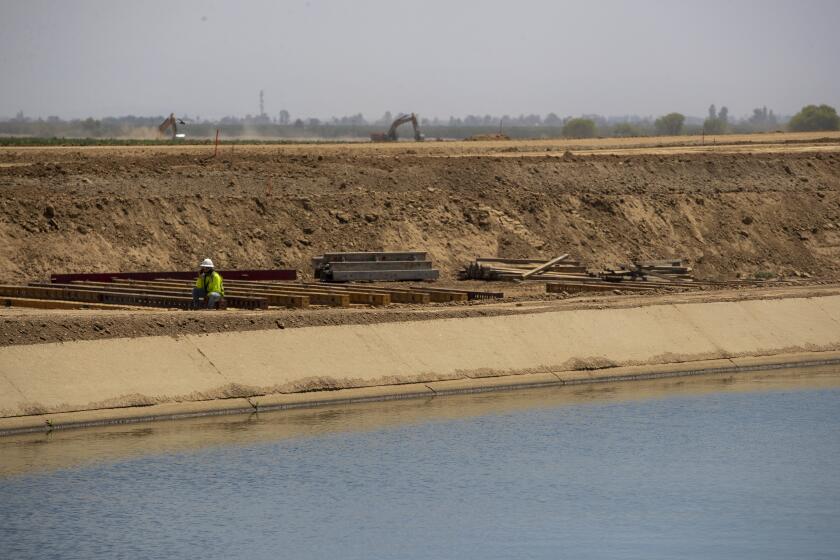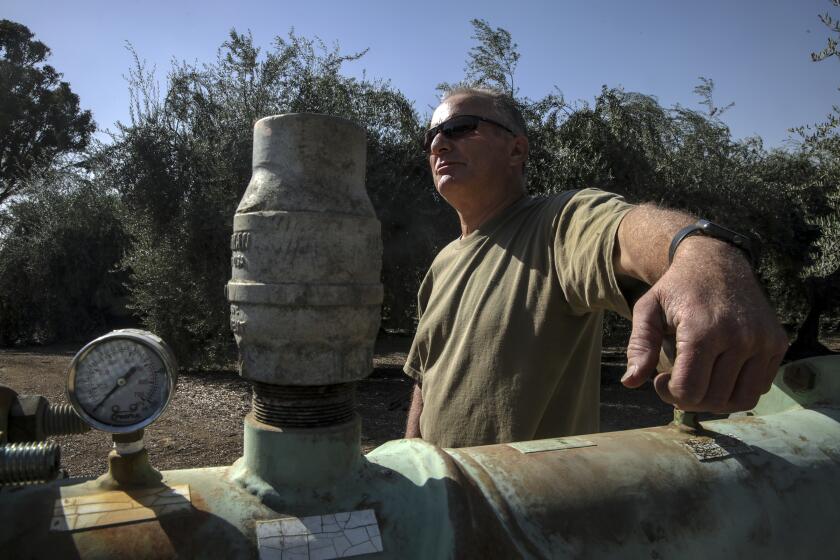Opinion: Why California will still have a water shortage no matter how much it rains this year
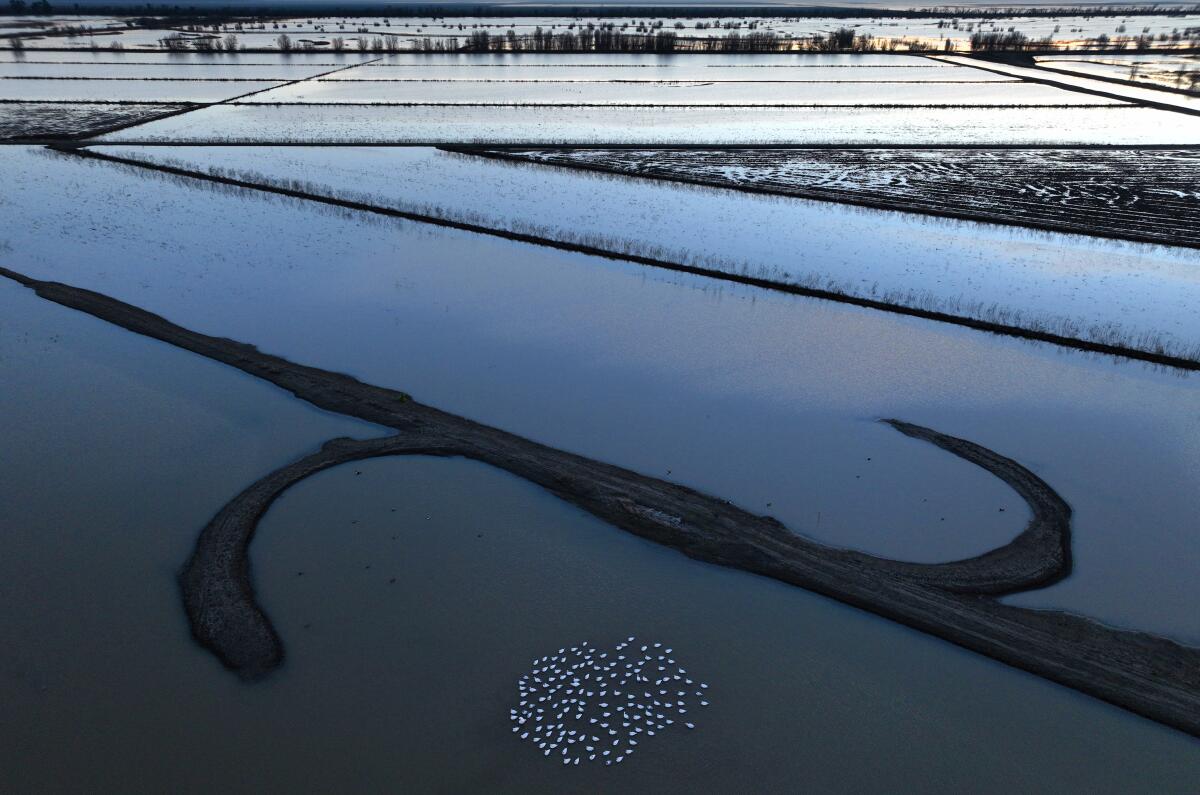
During a winter of blizzards, floods and drought-ending downpours, it’s easy to forget that California suffers from chronic water scarcity — the long-term decline of the state’s total available fresh water. This rainy season’s inundation isn’t going to change that.
How is this possible, given the unrelenting series of atmospheric river systems that have dumped near-record snowfall over the Sierra and replenished the state’s reservoirs?
It’s all about groundwater.
California uses more water each year — most of it for food production — than is supplied by renewable sources such as rain and snowfall, even in the wettest of winters like this one. The gap is filled by groundwater, which has for a century underpinned California’s water resources — in particular, during drought, when it provides 60% or more of agriculture’s irrigation water supply.
But groundwater can be renewed only slowly, to the extent it can be renewed at all.
In parts of California’s Central Valley, farmlands are being used to soak up storm water and replenish depleted groundwater.
It is the long-term disappearance of groundwater that is the major driver behind the state’s steady decline in total available fresh water, which hydrologists define as snowpack, surface water, soil moisture and groundwater combined.
Although this winter will rival or exceed precipitation totals from the wettest winters on record (1968-69; 1982-83), like those winters, this one will do little to stem groundwater depletion. The gains made during wet years simply can’t offset the over-pumping during the dry years in between. In fact, the state’s groundwater deficit is now so large that it will never be fully replenished.
In November, measurements made with NASA satellites showed California total freshwater levels had reached a 20-year low, probably the lowest ever for the state. Since 1961, 93 million acre-feet of groundwater has disappeared in the Central Valley, equivalent to 3.4 times the volume of Lake Mead at capacity. Since the 1860s, an estimated 142 million acre-feet has been depleted.
California has approved a plan to use more than 600,000 acre-feet of floodwaters to replenish groundwater and supply wildlife refuges in the Central Valley.
In 2014, California finally passed the Sustainable Groundwater Management Act, or SGMA, its first-ever regulation governing groundwater pumping. The law offers the opportunity to define a pathway toward groundwater sustainability, if not recovery. However, its slow implementation and lack of quantitative goals threaten to undermine its potential.
Under the law, local groundwater sustainability agencies were formed to manage the state’s depleted groundwater basins. Basin by basin, the agencies must develop and implement sustainability plans and get them evaluated by the California Department of Water Resources. The law sets 2042 as the target for achieving overall sustainability.
To date, however, the state has fully endorsed just 12 basin plans out of 94, and just this month it found the plans submitted for a large part of the San Joaquin Valley inadequate to deal with the region’s “critical overdraft” of groundwater.
SGMA‘s halting pace calls into question whether California can realistically meet its objective of full compliance in two decades. In fact, the long timeline is already having profoundly negative consequences.
California regulators say groundwater plans are inadequate in six areas of the San Joaquin Valley. The move triggers state intervention to bolster regulation.
In December, my research team published a report that showed groundwater depletion in California’s Central Valley accelerating during the megadrought years between 2019 and 2021, rather than slowing with the implementation of sustainability plans and rules. In those years, Central Valley groundwater disappeared at almost five times the long-term average depletion rate.
At first, the finding caught our research group off guard, but it was borne out by ground-based observations of water levels and by a record number of drying groundwater wells. In hindsight, we shouldn’t have been surprised. The specter of SGMA limits on groundwater use probably triggered a rush to drill more agricultural wells, to plant more thirsty nut trees and of course, to pump more groundwater.
In the midst of this winter’s atmospheric rivers, Gov. Gavin Newsom ordered 600,000 acre-feet of the state’s anomalously high river flows diverted to groundwater recharge and storage in the Central Valley. Along with other supply-side efforts, including Newsom’s decision last year to increase annual groundwater recharge by at least 500,000 acre-feet a year, that move could slow current rates of groundwater depletion by as much as 25%.
But such orders won’t guarantee California’s future water security. That depends squarely on the timely and successful implementation of the Sustainable Groundwater Management Act.
Well-drilling and pumping continue to draw down groundwater in California’s Central Valley. Calls are growing for stronger legislation and state intervention.
To speed groundwater sustainability, the state should devote additional resources to its evaluation and oversight effort.
Beyond that, California should supplement the Sustainable Groundwater Management Act in three ways.
First, it should mandate a comprehensive assessment of the volume of fresh water available in the state, how its quality and accessibility vary, what is renewable versus nonrenewable, and the environmental and human effects of pumping it. It’s shocking that this fundamental information is not well-known today.
The state also must be more transparent about what underlies its standards for the sustainability plans and recharge projects. California should have specific targets for reducing and halting groundwater depletion, just as it has for fossil fuel use and carbon dioxide emissions.
California’s Chinook salmon population is suffering, forcing the cancellation of the fishing season along the Pacific coast.
Is the current average depletion rate in the Central Valley — about 2 million acre-feet a year — the goal? To understand and plan for the future, Californians need to know what level of groundwater will be sustained, and how both recharge efforts and reduced pumping will be used to achieve that level.
Finally, industry — agriculture in particular — must account for its water use. The SGMA sustainability agencies are required to track overall water use; individual farms and ranches may not be. But California cannot achieve water security without a deep commitment to stewardship by industry, and stewardship requires that water use is routinely measured and reported.
Groundwater, even in its depleted state, is California’s most valuable water asset, and the Sustainable Groundwater Management Act is the state’s only hope to protect it. Should the law fail, it would be catastrophic.
California must be committed to doing everything in its power to ensure its success.
Jay Famiglietti is a global futures professor at Arizona State University. He is the former senior water scientist at NASA’s Jet Propulsion Laboratory, and a former member of the California Regional Water Boards in Santa Ana and Los Angeles.
More to Read
A cure for the common opinion
Get thought-provoking perspectives with our weekly newsletter.
You may occasionally receive promotional content from the Los Angeles Times.
